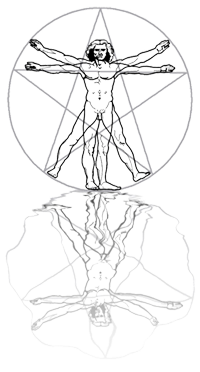BIODYNAMIC CRANIOSACRAL THERAPY
Having previously studied Swedish and Remedial massage coupled with Asian therapies; I have now been practicing BIODYNAMIC CRANIOSACRAL THERAPY in Armidale for fourteen years. I feel that Biodynamic Craniosacral Therapy can bring real lasting change to the body and mind.
The fact that there is no pain or discomfort involved, thereby not activating the Sympathetic Nervous System is a big part of this process; many more traditional modalities have an inherent discomfort level, thereby activating the Sympathetic Nervous System (fight-flight system). I do not believe that long term change can be brought to the body in this state. The axiom of “no pain= no gain” has no place in this modality.
The fact that there is no pain or discomfort involved, thereby not activating the Sympathetic Nervous System is a big part of this process; many more traditional modalities have an inherent discomfort level, thereby activating the Sympathetic Nervous System (fight-flight system). I do not believe that long term change can be brought to the body in this state. The axiom of “no pain= no gain” has no place in this modality.
Who can it help?
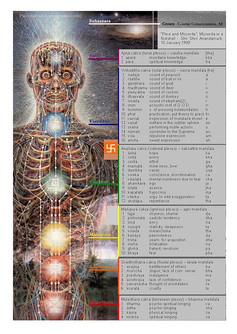
As with all modalities, I would like to think that I can help with all maladies; this is of course not the case. However, having practiced exclusively with this method for the past twelve years I can say that I have treated many varied chronic and acute conditions and injuries with a good success rate.I have treated clients from three months of age through to eighty-five years young.
I have treated the following conditions;
I have treated the following conditions;
- T.M.J. problems.
- Chronic and acute Migraines.
- Vertigo.
- Torticollis.
- Myopia.
- Post-operative tissue dysfunction.
- Tinnitus.
- Bursitis.
- Anxiety
- Assorted gait disorders.
- Assorted postural dysfunctions due to injury/trauma.
What is it?
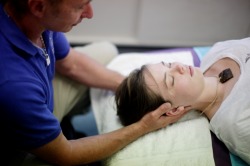
© James Day
EMBRYOLOGY AS A MODEL.
Erich Blechschmidt MD, a very well established and progressive embryologist, independently provided significant contributions to the field of Biodynamic Craniosacral work.
Dr. Blechschmidt carefully observed the cells of the developing embryo as the embryo changed shape. The cells would appear to migrate (move from one location to another) as they differentiate (change from one form into another), to ultimately become the structures of the adult organism.
Dr. Blechschmidt used the term "Biodynamics" to describe these movements of “metabolic fields” in the developing embryo. He felt that these dynamic fields of activity seemed to arise from the very geometry of the cellular foundations of life, and produced distinct patterns of movement.
Erich Blechschmidt MD, a very well established and progressive embryologist, independently provided significant contributions to the field of Biodynamic Craniosacral work.
Dr. Blechschmidt carefully observed the cells of the developing embryo as the embryo changed shape. The cells would appear to migrate (move from one location to another) as they differentiate (change from one form into another), to ultimately become the structures of the adult organism.
Dr. Blechschmidt used the term "Biodynamics" to describe these movements of “metabolic fields” in the developing embryo. He felt that these dynamic fields of activity seemed to arise from the very geometry of the cellular foundations of life, and produced distinct patterns of movement.
It is
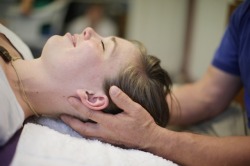
© James Day
On a purely physical level Craniosacral therapy is a gentle hands on treatment method that focuses on alleviating restrictions to physiological motion of the bones of the skull, including the facial bones, as well as the vertebral column, sacrum, coccyx and pelvis. Concurrently, the Craniosacral therapist focuses on normalizing abnormal tensions and stresses in the meningeal membrane, with special attention to the outer most membrane, the duramater and its connections. Attention is also paid to alleviating any obstacles to free movement by the cerebrospinal fluid within its membrane compartment, to normalizing and balancing perceived related energy fields.
As usually practiced this therapy is a non invasive treatment process that requires an uninterrupted treatment session of 30-45 minutes. Practitioners indicate that successful treatment relies largely on the therapist’s ability to facilitate the patient’s own self corrective processes within the Craniosacral system.
The most powerful effects of Craniosacral therapy are considered to be on the function of the central nervous system, the immune system, the endocrine system, and the visceral organs via the autonomic nervous system. This therapy has been used with reported success in many cases of brain and spinal cord dysfunction. Although the successes have not been documented in formal studies, they have been observed anecdotally by both patients and therapists. Most prominent amongst these success reports are cases of brain injury resulting in symptoms of spastic paralysis and seizure. Other areas of claimed success include cerebral palsy, learning disabilities, seizure disorders, depressive reactions, menstrual dysfunction, motor dysfunction, strabismus (vision disorder), tempromandibular joint problems, various headaches, chronic pain problems and chronic fatigue syndrome.
As usually practiced this therapy is a non invasive treatment process that requires an uninterrupted treatment session of 30-45 minutes. Practitioners indicate that successful treatment relies largely on the therapist’s ability to facilitate the patient’s own self corrective processes within the Craniosacral system.
The most powerful effects of Craniosacral therapy are considered to be on the function of the central nervous system, the immune system, the endocrine system, and the visceral organs via the autonomic nervous system. This therapy has been used with reported success in many cases of brain and spinal cord dysfunction. Although the successes have not been documented in formal studies, they have been observed anecdotally by both patients and therapists. Most prominent amongst these success reports are cases of brain injury resulting in symptoms of spastic paralysis and seizure. Other areas of claimed success include cerebral palsy, learning disabilities, seizure disorders, depressive reactions, menstrual dysfunction, motor dysfunction, strabismus (vision disorder), tempromandibular joint problems, various headaches, chronic pain problems and chronic fatigue syndrome.
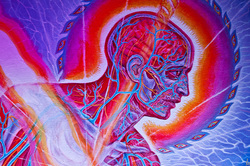
The patterns of metabolic field motion within the developing embryo (observed and described by Blechschmidt) appear to be identical to the movement patterns observed and described by William Sutherland in the process of Osteopathic Treatment.
In essence, the “generative” forces of the developing embryo are identical to the “regenerative” forces used for healing in all of us.
On the 14th day after conception a flat plate of tissue forms, known as the “embryonic plate.” On the 19th day, directly in the center of the embryonic plate, a line forms. This line, known as the “primitive streak,” seems to appear out of “nowhere,” and expands towards the head and tail.
This line becomes a tube - the neural tube, which becomes our central nervous system; expanding toward the head end to form the brain. Deep to the neural tube lies another structure know as the "notochord." This notochord functions as the mid line segmental organizer for all of embryologic development.
As adults, only vestigial remnants of this once dynamic notochord remain. But a line of function, a midline that organizes our physiology, persists to guide us throughout life. Everyone has several kinds of rhythms in their body. There is a cardiac rhythm in which the heart beats 60-80 times per minute. Then there is the respiratory rhythm of your breathing in which you inhale and exhale 15-20 times per minute. Underneath those, there is another rhythm called the Craniosacral Rhythm or Primary Respiration. In this rhythm your head gently expands and narrows and your spine gently lengthens and shortens in an effort to exchange and circulate cerebrospinal fluid. It does this 6-12 cycles per minute. The membranes that surround your head and spine act as a hydraulic pump that draws this clear fluid out of ventricles, bathes the brain and spinal cord and then returns it to the blood supply. In this way the cerebrospinal fluid is filtered and renewed. This fluid also supplies nutrients to the central nervous system, carries away waste products and acts as a fluid protective covering for the brain and spinal cord.
In essence, the “generative” forces of the developing embryo are identical to the “regenerative” forces used for healing in all of us.
On the 14th day after conception a flat plate of tissue forms, known as the “embryonic plate.” On the 19th day, directly in the center of the embryonic plate, a line forms. This line, known as the “primitive streak,” seems to appear out of “nowhere,” and expands towards the head and tail.
This line becomes a tube - the neural tube, which becomes our central nervous system; expanding toward the head end to form the brain. Deep to the neural tube lies another structure know as the "notochord." This notochord functions as the mid line segmental organizer for all of embryologic development.
As adults, only vestigial remnants of this once dynamic notochord remain. But a line of function, a midline that organizes our physiology, persists to guide us throughout life. Everyone has several kinds of rhythms in their body. There is a cardiac rhythm in which the heart beats 60-80 times per minute. Then there is the respiratory rhythm of your breathing in which you inhale and exhale 15-20 times per minute. Underneath those, there is another rhythm called the Craniosacral Rhythm or Primary Respiration. In this rhythm your head gently expands and narrows and your spine gently lengthens and shortens in an effort to exchange and circulate cerebrospinal fluid. It does this 6-12 cycles per minute. The membranes that surround your head and spine act as a hydraulic pump that draws this clear fluid out of ventricles, bathes the brain and spinal cord and then returns it to the blood supply. In this way the cerebrospinal fluid is filtered and renewed. This fluid also supplies nutrients to the central nervous system, carries away waste products and acts as a fluid protective covering for the brain and spinal cord.
Indigenous Wisdom
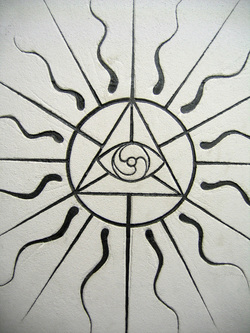
The rhythms of the Natural World surround us, permeate our very being, and give rise to our very breath. We depend upon these rhythms for our health and well being. These are the same biodynamic forces that move us from a single cell to fully formed adult; the same intrinsic biodynamic forces that restore our wounds, and bring us back into relationship with our highest level of function.
Our present civilization, its tempo and tone, numbs us to the natural rhythms around us; rhythms that inherently make sense when we take the time to listen and see.
As living beings, born of the natural world, we reference these innate rhythms in a fundamental way. Our very physiology seeks out relationship with and is nurtured by the rhythms of the natural world.
According to biodynamic principles, Primary Respiration is not limited to the boundaries of the human body. The outside presence of Primary Respiration is the invisible ether that gives rise to all that is manifest, living and non-living.
Definition
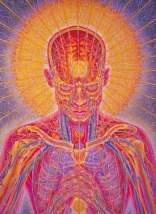
© alexgrey.com
Craniosacral therapy is a technique for tapping into the body’s many layers and matrices, using educated hands to sense and adjust tensions of fascia, viscera and subtle pressures of fluids, revitalizing organs and restoring underlying rhythms toward their inherent balanced state. It is also a para-physical art, using light intentional touch to transduce mind, matter and energy into one and other. I think of it as a mild non-invasive surgery-more delicate than any massage – with a wordless psychoanalysis whereby palpation releases cysts of trapped emotional and somatic energy. With other disciplines such as polarity, visceral manipulation, zero balancing and Myofascial release, CRANIOSACRAL THERAPY is the forerunner of a post-technological healing that parallels quantum physics in its capacity to weigh virtually imperceptible cellular vectors, use mindedness and breath to track and influence tissue systems and metabolic processes and translate probabilistic and hypothetical events into real ones. At that level it is a relativistic system that entertains paradoxical, even contradictory possibilities at the same time.

